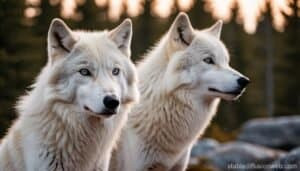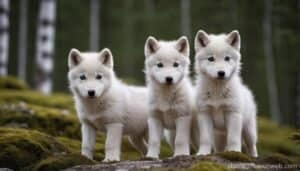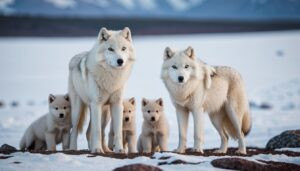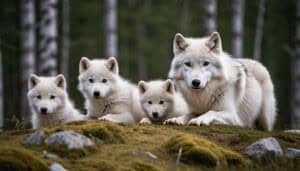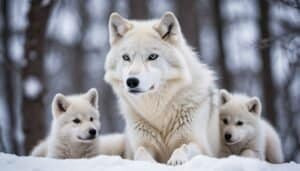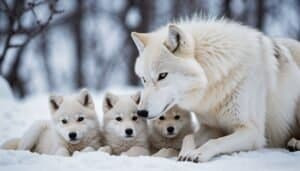Introduction
Arctic wolves, with their distinctive fur patterns, are marvels of nature perfectly adapted to their harsh environments. This article delves into the various factors influencing these patterns, including climate, genetics, and regional habitats
We will explore how seasonal changes and dietary habits impact fur quality and coloration, the role of camouflage, and how these adaptations compare to other wolf species
Through a detailed examination, we aim to uncover the intricate ways in which Arctic wolves thrive in some of the most extreme conditions on Earth
How Climate Influences Arctic Wolf Fur Patterns
Arctic wolves, also known as white wolves or polar wolves, are uniquely adapted to their frigid environments
Their fur patterns and textures vary significantly based on the climate conditions of their habitats, providing essential insulation and camouflage. Understanding these variations helps in appreciating how these animals thrive in such extreme conditions
Temperature Variations and Fur Density
One of the most critical factors affecting Arctic wolf fur patterns is the temperature of their environment. In regions with harsher, colder climates, Arctic wolves tend to have denser fur
This thick fur acts as an insulator, trapping heat close to the body and keeping the wolves warm even in temperatures that can plummet below -30°F (-34°C). Studies have shown that the density and length of fur in Arctic wolves are directly correlated with the severity of the winter season (Mech, 1970)
In contrast, during the brief Arctic summer, the fur becomes less dense. This seasonal shedding is essential as it prevents the wolves from overheating. The summer fur is shorter and less insulating, allowing the wolves to remain active and hunt efficiently without becoming overheated
This adaptation is crucial for their survival, given the significant temperature fluctuations in the Arctic regions
Impact of Snow and Ice on Fur Coloration
The snowy and icy landscapes of the Arctic have a profound influence on the coloration of Arctic wolf fur
The predominant white or light gray fur provides excellent camouflage against the snowy backdrop, aiding in both hunting and evasion of predators. This coloration is not just about blending in but also about reflecting solar radiation, which helps in maintaining a stable body temperature
Interestingly, the fur can also show subtle color variations, such as cream or light tan, depending on the specific region and environmental conditions
These variations are adaptations that have evolved to optimize camouflage in different types of Arctic terrain. For instance, in areas with a mix of snow and rocky outcrops, slightly darker fur patterns can help wolves blend more effectively into their surroundings
Seasonal Changes and Their Impact on Fur Color
Arctic wolves undergo significant changes in their fur coloration and texture with the changing seasons. This adaptation is essential for their survival in an environment that experiences extreme seasonal variations
Winter Fur vs. Summer Fur
During the winter, Arctic wolves develop a thick, white fur coat that provides excellent insulation against the cold and camouflages them in the snowy landscape
This winter coat is typically dense and plush, offering maximum protection against the biting cold and wind. The white coloration helps them blend into the snow, making it easier to stalk prey and avoid detection by predators
In summer, the fur becomes shorter and less dense, with a more pronounced gray or tan hue. This change not only helps in shedding excess heat but also provides camouflage against the summer landscape, which includes bare ground and vegetation patches
The summer fur is often more mottled, which helps in blending into the varied summer terrain
Molting Process and Fur Transformation
The transition from winter to summer fur, and vice versa, involves a process called molting
Molting is a gradual shedding of the old fur and the growth of new fur. This process is triggered by changes in daylight length and temperature, ensuring that the wolves’ fur is well-suited to the upcoming season
Molting typically occurs in late spring and early autumn. During these periods, Arctic wolves may look scruffy as they lose their thick winter coat and grow a lighter summer coat, or vice versa
The new fur that grows during molting is perfectly adapted to the environmental conditions they will face, showcasing nature’s remarkable ability to prepare these animals for seasonal changes
Genetic and Evolutionary Factors Affecting Arctic Wolf Fur Variations
Arctic wolves exhibit a wide range of fur patterns influenced by genetic and evolutionary factors. These variations are not only a result of immediate environmental conditions but also the product of long-term evolutionary adaptations that have enabled these wolves to survive and thrive in their harsh Arctic habitats
Inherited Fur Traits
Genetics play a crucial role in determining the fur characteristics of Arctic wolves. Fur color, density, and pattern are inherited traits passed down from generation to generation. Genetic variation within the Arctic wolf population allows for a range of fur patterns, which can be seen in different packs and regions
For instance, a study by Carmichael et al. (2001) found that genetic diversity within Arctic wolf populations is relatively high, despite their isolated habitats
This genetic diversity is crucial for the survival of the species as it allows for a variety of fur patterns that can better adapt to changing environmental conditions. Wolves with fur traits that are well-suited to their specific environment are more likely to survive and reproduce, passing on these advantageous traits to their offspring
Genetic Mutations and Fur Color
Occasionally, genetic mutations can result in unique fur patterns or colors within the Arctic wolf population
These mutations may lead to rare color variations, such as black or brown fur, though these are less common. Such mutations can provide researchers with insights into the genetic mechanisms that control fur characteristics
One well-documented example of genetic influence on fur color is the K locus, which affects coat color in many canid species. Mutations in the K locus can lead to a variety of fur colors and patterns, demonstrating how genetic changes can influence physical traits (Anderson et al., 2009)
While less common in Arctic wolves due to their predominantly white fur, these genetic insights help scientists understand the broader mechanisms at play
Evolutionary Advantages of Different Fur Patterns
The fur patterns seen in Arctic wolves today are the result of thousands of years of evolution. These patterns offer several evolutionary advantages that enhance the wolves’ ability to survive and reproduce in the Arctic environment
Survival Benefits of Varied Fur
Different fur patterns can provide specific survival benefits. For instance, wolves with fur that better blends into their environment are less likely to be seen by prey or predators
This camouflage increases their hunting success and decreases their risk of predation. In regions where the landscape includes more rocky outcrops or vegetation, slightly darker fur can offer better concealment, providing a selective advantage
Moreover, the thickness and insulation properties of fur are critical for survival in extreme cold. Wolves with denser, more insulating fur are better protected against the severe Arctic winter, increasing their chances of survival
Over time, these advantageous traits become more common in the population through the process of natural selection
Adaptive Evolution in Arctic Wolves
Adaptive evolution in Arctic wolves is evident in the variety of fur patterns and colors adapted to different environmental niches
Wolves in coastal regions, where the landscape is often more varied with less snow cover, may develop different fur patterns compared to those living in the interior Arctic regions with more consistent snow cover
For example, research indicates that wolves in the High Arctic islands tend to have lighter, more uniform fur patterns, while those in mainland regions exhibit more varied and darker patterns (Geffen et al., 2004). These differences reflect the specific selective pressures in their respective environments, highlighting the adaptive nature of their fur
Genetic and evolutionary factors are central to the diversity of fur patterns in Arctic wolves
The interplay of inherited traits, genetic mutations, and evolutionary pressures has resulted in a population well-adapted to the varied and extreme conditions of the Arctic. By understanding these factors, we gain a deeper appreciation for the complexity and resilience of these remarkable animals
Regional and Habitat-Specific Differences in Fur Patterns
The fur patterns of Arctic wolves are not uniform across their range but vary significantly depending on their specific regions and habitats. These differences are shaped by the unique environmental conditions and ecological niches that these wolves occupy
Primary Colors and Patterns Seen in Arctic Wolf Fur Across Regions
Common Fur Colors
Arctic wolves are primarily known for their white fur, which is the most common color and provides excellent camouflage in snowy environments
However, variations can occur, and some wolves may exhibit shades of gray, cream, or light tan. These colors help them blend into different Arctic landscapes, from snow-covered plains to rocky tundra
White fur is particularly advantageous during the winter months when the ground is covered in snow. It helps the wolves remain inconspicuous while hunting and protects them from potential predators
In contrast, during the summer, when the snow melts, the slightly darker fur helps them blend into the more varied terrain, including patches of bare ground and vegetation
Regional Differences in Fur Patterns
Regional differences in Arctic wolf fur patterns are influenced by the specific environmental conditions of each area
For example, wolves in coastal regions, where the landscape includes more open water and varied terrain, may have fur patterns that incorporate more gray or tan shades. These variations help them blend into the mixed environment of ice, rock, and sparse vegetation
In contrast, wolves living in the High Arctic, where the landscape is predominantly snow-covered for most of the year, tend to have more uniformly white fur. This uniformity provides optimal camouflage in a consistently snowy environment, enhancing their ability to hunt and avoid predators
Distinct Arctic Wolf Fur Patterns in Specific Regions
Arctic Coastal Areas
Arctic wolves living in coastal areas often exhibit fur patterns that reflect the diverse terrain of their habitat
The presence of open water, rocky outcrops, and patches of vegetation creates a more varied landscape. Consequently, wolves in these regions may have fur with more pronounced gray or tan hues, which helps them blend into the coastal environment. This camouflage is crucial for stalking prey such as seals and seabirds, which are abundant in these areas
Inland Arctic Regions
Inland Arctic regions, characterized by vast expanses of snow and ice, are home to wolves with more uniform fur patterns. The predominantly white or light gray fur provides excellent camouflage in the continuous snow cover, aiding in hunting and predator evasion
These wolves rely on caribou and musk oxen as primary food sources, and their fur patterns help them remain undetected as they approach their prey across the open tundra
Habitat and Its Role in Fur Pattern Development
Habitat-Specific Fur Adaptations
The specific habitat of an Arctic wolf significantly influences its fur pattern
Wolves living in areas with varied terrain, such as coastal regions with rocks and sparse vegetation, develop fur patterns that incorporate a mix of colors. These adaptations ensure they are well-camouflaged in their environment, which is essential for successful hunting and avoiding detection
In contrast, wolves in more homogenous environments, like the High Arctic’s snow-covered plains, exhibit less variation in fur color. Their predominantly white fur provides the best camouflage in a landscape dominated by snow and ice
These habitat-specific adaptations highlight the remarkable ability of Arctic wolves to adjust their fur patterns to optimize survival in their particular environments
Environmental Stressors and Fur Changes
Environmental stressors, such as extreme cold, food scarcity, and changes in habitat, can also influence fur patterns
For example, during periods of food scarcity, wolves may experience changes in fur quality and density due to nutritional deficiencies. Stressful environmental conditions can lead to increased shedding or changes in fur coloration, reflecting the health and well-being of the wolf
Moreover, as climate change continues to impact Arctic regions, shifts in habitat and environmental conditions may lead to changes in fur patterns. Warmer temperatures and melting ice can alter the landscape, potentially affecting the camouflage and insulation properties of Arctic wolf fur
Understanding these potential changes is crucial for conservation efforts aimed at protecting these iconic predators in a rapidly changing world
Camouflage, Diet, and Social Behavior Influences on Fur Patterns
Arctic wolves’ fur patterns are influenced not only by environmental factors and genetics but also by their need for effective camouflage, their diet, and social behaviors within their packs. These factors play significant roles in the daily lives and long-term survival of these wolves
The Role of Camouflage in Arctic Wolf Fur Patterns
Camouflage is a critical survival mechanism for Arctic wolves, allowing them to hunt efficiently and avoid predators. The fur patterns and colors of these wolves are finely tuned to their environments, providing them with a stealthy advantage in the snowy and rocky landscapes of the Arctic
Predation and Camouflage Strategies
Arctic wolves rely heavily on their fur for camouflage during hunts. The white or light gray fur blends seamlessly with the snow, making it difficult for prey such as caribou and musk oxen to detect their approach
This stealth is crucial, as the open Arctic landscape offers little cover. Wolves must get as close as possible to their prey without being seen to ensure a successful hunt
In coastal areas or regions with more varied terrain, the inclusion of gray or tan hues in their fur helps them blend into the rocks and sparse vegetation. This adaptive camouflage allows them to ambush seals or seabirds near the shore
The ability to adapt their hunting strategies to different environments showcases the versatility and adaptability of Arctic wolves
Fur Patterns and Hunting Success
The success of hunting strategies is closely tied to the effectiveness of a wolf’s camouflage. Studies have shown that wolves with fur patterns that closely match their surroundings have higher hunting success rates (Mech, 1997)
This correlation highlights the evolutionary advantage of fur patterns that provide optimal camouflage, as wolves with better camouflage are more likely to catch prey and, consequently, survive and reproduce
For instance, in the High Arctic, where snow cover is almost perpetual, wolves with predominantly white fur have higher success rates in hunting compared to those with darker fur. This success is due to their ability to remain undetected in the vast snowy landscape, allowing them to approach prey more closely before launching an attack
The Influence of Diet on Fur Quality and Color
A wolf’s diet significantly impacts the quality and coloration of its fur. Nutritional intake plays a vital role in maintaining healthy fur, and variations in diet can lead to differences in fur patterns and overall health
Nutritional Impact on Fur Health
The health and appearance of Arctic wolves’ fur are directly influenced by their diet
A nutrient-rich diet, high in essential vitamins and minerals, promotes healthy fur growth, making it thicker, shinier, and more resilient to environmental stressors. Wolves that consume a diverse diet, including meat from caribou, musk oxen, seals, and smaller mammals, typically exhibit healthier fur
Conversely, a poor diet or periods of food scarcity can lead to dull, brittle fur that is prone to shedding. Nutritional deficiencies can cause changes in fur texture and coloration, making the wolves less effective at camouflage and more susceptible to cold
Ensuring access to a stable and abundant food source is crucial for maintaining the fur quality that Arctic wolves need for survival
Prey Types and Fur Coloration
The types of prey available in different regions can also influence fur coloration. For example, coastal wolves that consume a diet rich in marine mammals may exhibit slight differences in fur texture and color compared to inland wolves that primarily hunt terrestrial animals
The high-fat content of marine mammal diets can result in glossier and more insulated fur, providing better protection against the cold
Additionally, the availability of specific prey types can affect the overall health of the wolf population in a region, indirectly influencing fur patterns through nutritional status. Regions with abundant prey support healthier wolf populations, which in turn exhibit better fur quality and more effective camouflage patterns
Social Behavior and Its Impact on Fur Patterns
Social behaviors within wolf packs also play a role in the development and maintenance of fur patterns. These behaviors can influence fur quality, as well as the overall health and well-being of the wolves
Social Hierarchy and Fur Quality
The social structure of a wolf pack can impact individual fur quality. Dominant wolves, often the alpha male and female, typically have access to better food resources and may exhibit healthier, more vibrant fur
Their higher status ensures they get the first choice of prey, leading to better nutrition and subsequently better fur condition
Subordinate wolves, on the other hand, may have to wait for their turn to feed and might not get the same quality or quantity of food. This disparity can lead to differences in fur quality within the pack, with dominant wolves displaying thicker, shinier fur compared to their subordinates
Group Living and Fur Maintenance
Living in a pack also facilitates fur maintenance through grooming behaviors
Wolves often groom each other, which helps in maintaining fur quality by removing parasites, dead hair, and debris. This social grooming reinforces pack bonds and contributes to the overall health and appearance of their fur
Grooming behaviors are particularly important during the molting seasons when wolves shed their old fur and grow new fur
Pack members assist each other in removing loose fur, which helps in the efficient transition between seasonal coats. This cooperative behavior ensures that the entire pack maintains healthy and effective fur patterns suited to the changing environment
The interplay of camouflage, diet, and social behavior significantly influences the fur patterns of Arctic wolves. Effective camouflage is vital for hunting success and predator evasion, while diet impacts fur quality and health
Social behaviors within packs ensure that wolves maintain their fur through cooperative grooming and hierarchical access to resources. Understanding these influences provides a comprehensive view of the complex factors that shape the fur patterns of these remarkable animals
Fur Development and Adaptation to Extreme Conditions
The development of Arctic wolf fur and its adaptation to extreme Arctic conditions are crucial for the survival of these animals. From birth to adulthood, Arctic wolves undergo significant changes in their fur, and their ability to withstand harsh weather conditions is a testament to their remarkable resilience
Fur Pattern Changes from Pup to Adult
Developmental Stages of Fur
Arctic wolf pups are born with a soft, fuzzy coat that provides initial warmth and protection. This natal fur is typically darker than the fur of adult wolves, often showing shades of gray or brown. As the pups grow, their fur undergoes several changes to prepare them for the harsh Arctic environment
At around three months old, pups begin to develop their juvenile coat, which is thicker and offers better insulation
This coat gradually lightens as the wolves age, reflecting the need for camouflage in the snowy landscape. By the time they reach adulthood, Arctic wolves have developed the dense, white or light gray fur that is characteristic of the species
Adaptations Over Lifespan
The fur of Arctic wolves continues to adapt throughout their lives, responding to environmental conditions and the needs of the wolf
Seasonal changes trigger molting, where old fur is shed, and new fur grows in its place. This process ensures that the wolves have the appropriate fur density and coloration for each season
In winter, adult wolves grow a thick, insulating undercoat that traps heat close to the body. This undercoat is complemented by longer guard hairs that repel snow and water, keeping the wolves dry and warm. In summer, the undercoat is shed, and the remaining fur becomes lighter and less dense, helping the wolves stay cool in milder temperatures
Common Fur Textures in Different Arctic Regions
Softness and Density Variations
The texture of Arctic wolf fur can vary depending on the region and environmental conditions. In extremely cold areas, the fur tends to be denser and softer, providing maximum insulation. This dense fur is essential for retaining body heat in temperatures that can drop to -40°F (-40°C) or lower
Wolves in slightly milder regions may have fur that is less dense but still offers adequate protection against the cold. The balance between softness and density ensures that the wolves remain comfortable and well-insulated in their specific habitats
Regional Textural Differences
Regional differences in fur texture can also be observed among Arctic wolves. For example, wolves living in coastal regions with higher humidity levels may have fur that is slightly oilier and more water-resistant. This adaptation helps them stay dry in wet conditions and provides additional protection against the cold
Inland wolves, on the other hand, may have fur that is more suited to dry, frigid environments. Their fur is typically fluffier and less oily, optimized for trapping heat and providing insulation against the biting cold winds of the Arctic tundra
Adaptation of Arctic Wolf Fur to Extreme Weather Conditions
Fur Resilience in Harsh Climates
Arctic wolves have evolved to possess fur that is incredibly resilient to the harsh climates they inhabit. Their fur provides a barrier against extreme cold, wind, and moisture, ensuring their survival in one of the most inhospitable environments on Earth
The fur’s structure, with a dense undercoat and longer guard hairs, creates an effective insulating layer that traps body heat while keeping out the cold. This resilience is vital for maintaining body temperature and preventing hypothermia during the long Arctic winters
Behavioral Adaptations to Protect Fur
In addition to the physical adaptations of their fur, Arctic wolves exhibit behavioral adaptations that help protect and maintain their fur. For instance, they often seek shelter in dens or snow burrows during severe weather conditions, reducing exposure to the elements and conserving body heat
Wolves also engage in behaviors such as curling up into a tight ball to minimize heat loss from exposed body surfaces
By tucking their noses under their tails and using their fur as a blanket, they effectively retain body warmth. These behavioral strategies complement their fur’s physical properties, ensuring maximum protection against the extreme Arctic climate
The development and adaptation of Arctic wolf fur are crucial for their survival in the extreme conditions of the Arctic. From the changes in fur patterns from pups to adults to the regional and textural differences influenced by their habitats, these adaptations highlight the incredible resilience of Arctic wolves
Their fur provides essential insulation, camouflage, and protection, enabling them to thrive in some of the harshest environments on the planet
Comparing Arctic Wolf Fur Patterns with Other Wolf Species
Understanding how Arctic wolf fur patterns compare to those of other wolf species offers valuable insights into the adaptive strategies of these remarkable animals. By examining the differences and similarities, we can appreciate the unique characteristics that enable Arctic wolves to survive in their specific habitats
Differences Between Arctic Wolves and Gray Wolves
Arctic wolves (Canis lupus arctos) and gray wolves (Canis lupus) share a common ancestor, but their fur patterns have diverged significantly due to their different habitats and environmental pressures
Gray wolves are found in a variety of habitats, including forests, mountains, and grasslands, which results in a wide range of fur colors and patterns. Their fur can be gray, black, white, brown, or a mix of these colors, providing camouflage suited to their diverse environments
In contrast, Arctic wolves are predominantly white or light gray, reflecting the need for camouflage in snow-covered landscapes
Additionally, the fur of Arctic wolves tends to be thicker and more insulating than that of gray wolves, an adaptation to the extreme cold of the Arctic. Gray wolves have fur that is well-suited to moderate climates, with a balance of insulation and breathability
Comparative Analysis of Fur Adaptations
A comparative analysis of fur adaptations between Arctic wolves and other wolf species highlights the evolutionary strategies that have enabled each species to thrive in their respective environments
Arctic wolves have developed a dense undercoat and long guard hairs that provide exceptional insulation against the cold, while gray wolves possess fur that is adaptable to a range of temperatures, with a mix of insulating and cooling properties
This distinction underscores the importance of fur adaptations in meeting the specific needs of different habitats
Furthermore, the color and pattern variations in gray wolves reflect their need for camouflage in varied terrains, from dense forests to open plains. Arctic wolves, with their more uniform white fur, demonstrate a specialized adaptation to a consistently snowy environment, showcasing how fur patterns can evolve to meet the demands of specific ecological niches
Comparing the fur patterns of Arctic wolves with those of other wolf species reveals the unique adaptations that each species has developed to survive and thrive in their environments. Arctic wolves’ dense, white fur is a specialized adaptation to the extreme cold and snowy landscapes of the Arctic, while gray wolves exhibit a broader range of fur patterns suited to diverse habitats
These differences highlight the remarkable flexibility and resilience of wolves as a species, capable of adapting to a wide array of environmental challenges
Conclusion
Arctic wolves’ fur patterns are a fascinating reflection of their adaptability and resilience in some of the harshest environments on Earth. Influenced by climate, genetics, diet, and social behavior, their fur provides essential insulation and camouflage, ensuring their survival
Seasonal changes and regional variations further highlight the complexity of these adaptations. Comparing Arctic wolves to other wolf species underscores the unique evolutionary strategies that enable them to thrive in their specific habitats
Understanding these intricate fur patterns offers valuable insights into the remarkable ways in which Arctic wolves have evolved to endure and flourish in the Arctic


